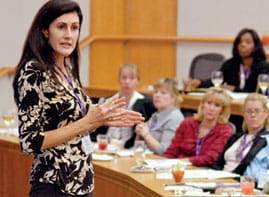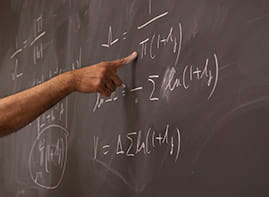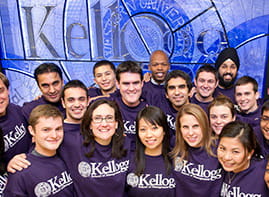1/8/2009 - Instead of making predictions about which NFL team will reign as the Super Bowl champion, Kellogg School marketing professors Tim Calkins and Derek Rucker are focused on assessing how advertisers will fare in the most-watched televised sporting event in the U.S.
The faculty members lead the
Kellogg School Super Bowl Advertising Review, a Feb. 1 event that brings together Kellogg marketing experts and students to evaluate advertising during the marquee event, ranking the ads based on several criteria. Kellogg began the Review in 2005 as another way to enhance experiential learning for students, while also highlighting the school’s marketing expertise.
Companies spend millions of dollars to obtain a coveted spot during the NFL’s biggest game of the year — this year, a 30-second ad costs about $3 million — but many observers are wondering how the U.S. recession will impact what viewers see come Super Bowl Sunday. Calkins and Rucker shared their insights and expectations in advance of the Review.
Amy Trang: What are the key things you will be watching for during this year’s Super Bowl ?
Prof. Derek Rucker: We’ll be interested to see the tonality of the brands in these economic circumstances. Will it be the same as previous years or will there be a little more somberness with the humor? Will it be flashy like it has in previous years or will the ads be more clever without being ostentatious in the execution? It might vary by brand.
Prof. Tim Calkins: How will Super Bowl advertising go over with consumers? Will it still resonate and be a focal point with consumers in this environment? Or, given the economic woes, will consumers see it as a less of a relevant topic for them? We’ve never seen a Super Bowl in its current form take place in an economic downturn like this. Will it still connect with people? Will people still want to be entertained?
AT: What are the brands we can expect to see during the game, and who looks like they’re going to sit it out?
Prof. Rucker: Budweiser is going to be back. Super Bowl has a lot of equity for them. They are in a product category that is still very affordable even in these tough economic times. Their message might be a little more somber. They might play it a little more safe, not wanting to have over-the-top cheer in these tough times. Bud is a downscale product and actually is in a good position to use the Super Bowl to maintain its balance in the market.
Prof. Calkins: This year will be a funny one when it comes to Super Bowl advertising. A lot of these advertisers made decisions about the Super Bowl when they were facing a different economic environment. The roster of advertisers we will see will partly reflect the recession’s impact, but a little bit of it will reflect on who committed early to the game. There is no question that we will see something in a shift in the advertising composition. The biggest change is the reports that suggest U.S. automakers all are absent from the game.
If there is one advertiser that is making the wrong call now it is General Motors. Bowing out of the game sends out a very negative signal about GM’s prospects and about the U.S. auto industry because it shows that they lack confidence and news. And what the companies do need right now is to project confidence and talk about news.
AT: What are the key elements that advertisers think about when they pay $3 million for a 30-second spot?
Prof. Calkins: There’s no one line of thought that is consistent across all advertisers. For each advertiser, it’s a tough decision and a decision that is made for various reasons. For those who have been in it in prior years it’s a question of “Do we come back and do it again?” If you’ve been there and you walk away, that sends an interesting message. It may say we no longer have the news to justify the spot, or have the resources to invest in the brand. For new advertisers, there is the question of news and branding. You see advertisers step up because they either want to build their brand or they have news to communicate.
AT: What has driven the enthusiasm for these Super Bowl commercials over time?
Prof. Calkins: Super Bowl is an astonishing event. For the U.S., it’s very much a shared experience. We actually don’t have many of these experiences in the U.S. these days. We live in a world of fragmentation, so everybody is watching different stuff all the time. There are hundreds of television stations and millions of Web sites, and little in the way of shared experiences anymore. The Super Bowl is something that so many people watch all at once and it provides this wonderful fodder for discussion.
It’s the one time where people want to watch the commercials. For an advertiser, that’s incredibly powerful. It’s a remarkable marketing opportunity, but it’s also a challenge because the viewers want to be entertained and are looking for something extraordinary. So for the Super Bowl, you can’t run a dull spot or run a spot you’ve run before frequently or a spot that is offensive in any way. For a marketer, it’s a very tough decision to buy a Super Bowl spot, because you are inviting scrutiny in a way you don’t do in any of your other marketing efforts. When you are buying a Super Bowl ad, you are saying, “Look at us, because this is something special.” That’s wonderful, but you have to deliver.
AT: What do you want students to gain from attending and participating in the Advertising Review?
Prof. Rucker: One of the strengths of Kellogg is its experiential learning — the hands-on application of the theory that students learn in the classroom. We take the basic framework that I cover in my ad abstract class and apply it to the strengths and weaknesses of the respective ads we’re seeing. It’s on-the-spot application of the fundamental principles that students have learned.






